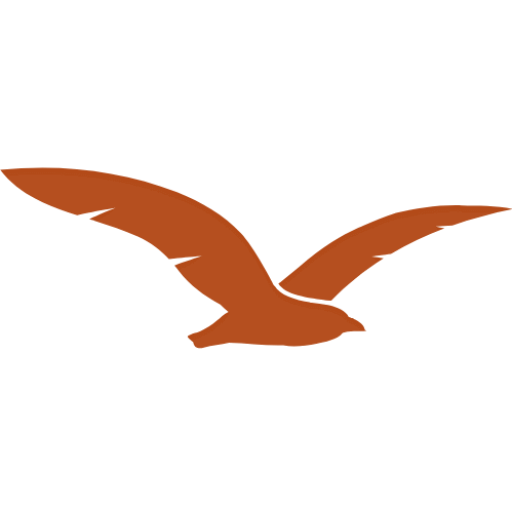As we know many Desert birds can survive in deserts without water and food, but is this true or there are secrets behind this? The secret is all these birds know physiological adaptations that make them live in the desert even though of the lack of water.
This article includes 8 desert birds you need to know and everything about them, in addition to how they survive in deserts without food and water.
First, What is a desert?
The desert as we know is an area that gets less than 10 inches of rain every year, and it is known for the high level of temperature as it makes it hard to live for humans, animals, and birds. By the way, I live in a desert area called Merzouga located in North Africa. So every piece of information you will read in this article is from a son of the desert. and I live these things every day.
It’s not important to have dunes to call a desert, the desert can include dunes, mountains, and flat and dry spaces.
The biggest desert in the world is not the Sahara, the biggest is the Antarctic Desert located in Antarctica, next to it is the Arctic Desert located in Eastern Europe, Northern America, Northern Asia, and Northern Europe, and next to it is the Sahara Desert located in Eastern Africa, Middle Africa, Northern Africa, Western Africa.
How Can Desert Birds Survive Without Water?
The truth is, desert birds don’t live without water, but they change some things that they do, some behaviors, and physiological, to adapt to the desert temperature.
I think you don’t know this info, there are two types of birds my friends. the first type is the bird that drinks water and there are other birds that we can say don’t drink water relatively but don’t rush, we’ll figure out how to do it, first let’s talk about the first type.
the first type is drinking water where they find small lakes, and they can travel for long distances looking for water, If they find an area where water is available, they stay there until the water is depleted and then they go to another place to look again for water.
the second type gets water from food like weeds, grains, and insects, as these food sources contain also water inside them, and some birds get water from the air. you will ask me how? They go to high space open their mouth and inhale the air, their bodies have a mechanism that converts the moisture in the air into water.
I will tell you also that their bodies are configured to not consume a lot of water so they can stay a long time with little water without any problems.
Desert Birds You Need to Know:
Let’s see the most and the best 8 birds that live in the desert there are a lot of things you need to know about them.
1-Desert Sparrow:
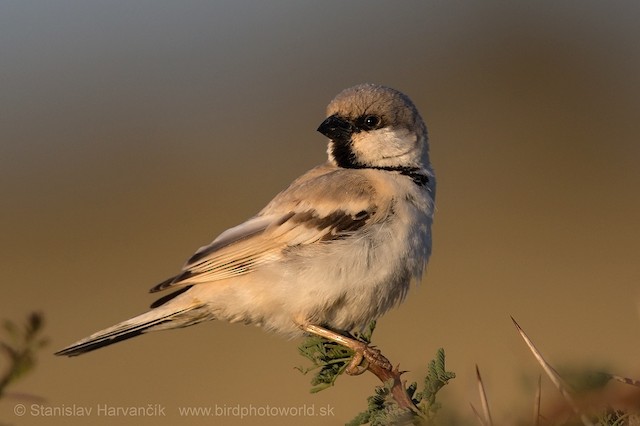
Desert Sparrow (Passer Simplex) is a bird that lives in deserts considered the hardest areas to live, especially in summer, it’s from the sparrow family found in the Sahara desert of northern Africa.
This bird as I mentioned in an article about it here doesn’t live in areas where other birds live, because he prefers to live alone or only with communities from the same type of desert sparrows, when the birds that live in cities come to its place, desert sparrow leave that place.
These birds live in areas near villages I see them sometimes near my house or on the walls of my house, the houses in my village are built only from mud clay, and there are holes above the walls that makes desert sparrow build their nests they on the holes because they don’t have any problem to live near humans.
When we saw it in our village people considered it as a sign that good was coming, and people loved it so much that their beliefs
2-Cactus Wren:
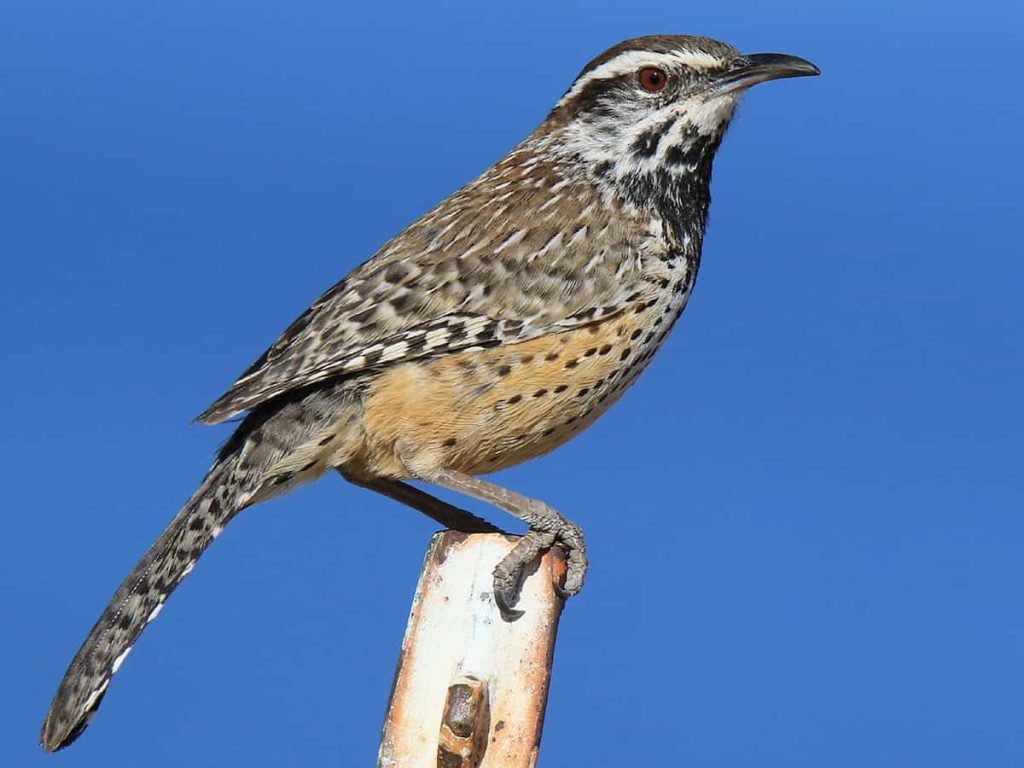
The Cactus wren is considered one of the most popular birds you can see a lot in deserts, it’s found in the southwestern United States and northern Mexico. It is the state bird of Arizona.
the source food of this bird is like other desert birds they feed on butterflies, insects, spiders, and grasshoppers. and the water source is lakes and cactus fruits. or these food sources that we mention can also contain some water that makes them live in this hard area.
I was really surprised when I knew these birds build their nests in thorny vegetation or cacti, and the reason is to protect themselves from wild animals, They often choose the cholla, prickly pear, or saguaro cacti, as their spines offer natural deterrents to predators.
Their nests are made primarily from grass, twigs, leaves, and other plant materials. Its structure is globular and large in addition to the entrance hole beside it. it has an outer layer that consists of thorny sticks and cactus segments which are like natural shields that protect them from predators.
The breeding time of Cactus wren typically differs due to climate factors and food availability, but most time start breeding from February to September, and they lay from 3 to 5 eggs every year.
The incubation period does not take a long time, it’s only 16 or 17 days, while this period the male and females take turns incubation, to give enough warmth to the eggs to hatch.
3-Verdin:
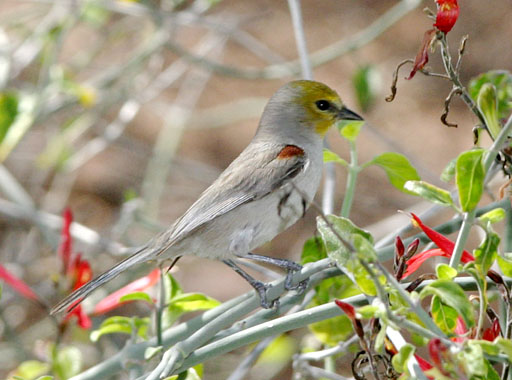
Verdins are birds that are not migratory and they still all their life in one place, they are found in the American desert region of Chihuahuan, Mojave. and Sonora. These birds are so beautiful from the side of colors, and shape, as its color is gray and has a little yellow on its head.
their diet consists mainly of insects and feeds on a variety of small invertebrates including, spiders, and their larvae. it is so fast in hunting, as it can hunt insects in the sky, twigs, and ground.
they build their nests on twigs, thorny shrubs, mesquite trees, cacti, or other dense vegetation. they prefer to live in areas that are thorny plants to protect themselves from predators and eagles like all desert birds, I Like how they are intelligent.
The breeding time of verdins usually starts to begin around February or March and can extend into June or July. and it varies according to the climate, food availability, and the area.
they lay 3 to 6 eggs every year, and The female Verdin will incubate the eggs for about 12-14 days until they hatch.
4-Indigo Bunting:
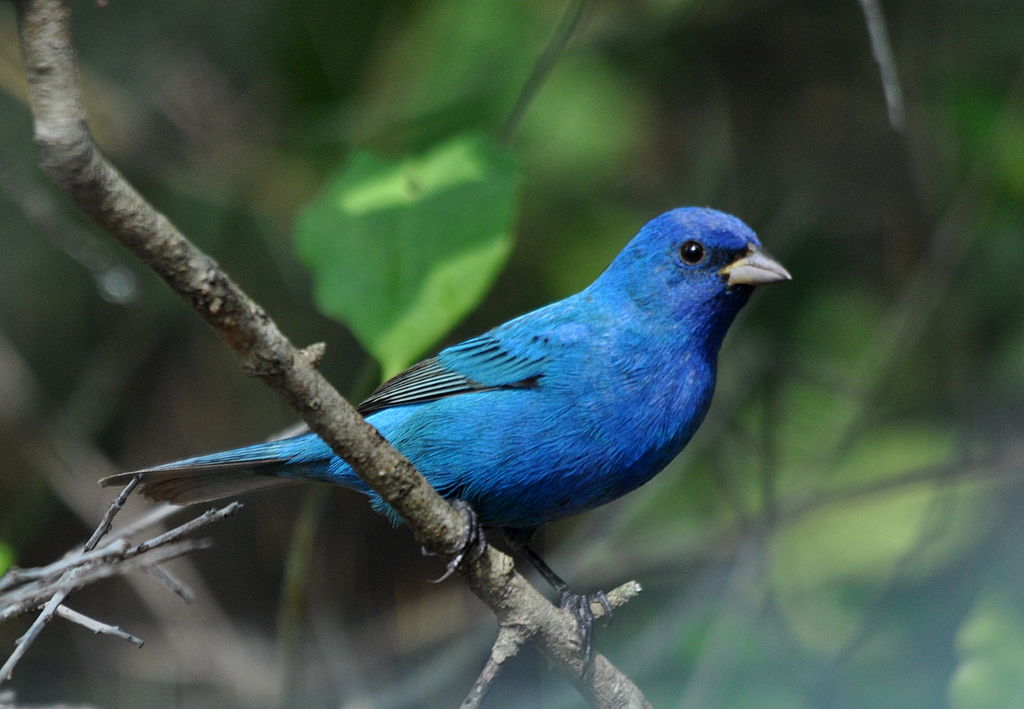
brilliant are birds that are located in the South and the North of America, these birds feed on tiny seeds because it’s the plants that are available a lot in these areas. these birds don’t live in deserts a lot, but you can find them in harsh areas during the immigration period.
indigo bunting is classified as small birds as its size is from 12-13 centimeters (4.7-5.1 inches) in length, this size makes them lightweight enough to hunt fast. they usually feed on insects, berries, and seeds.
the breeding season of these birds starts from late spring to early summer, and this is due to the food availability and the place where they are. they lay from 2 to 5 eggs.
the nest of this bird is relatively different from other nests of other birds, as it builds its nest in the form of a cup using a variety of materials including grass to build the foundation of its nest to be comfortable, and leaves that look like an exterior form of the nest to protect them from the high temperature, in addition to Bark Strips to reinforce the nest.
5-Gila Woodpecker:
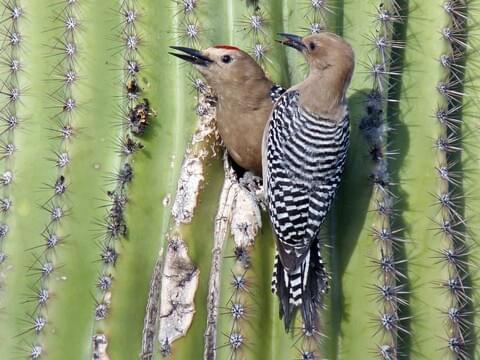
As we know woodpeckers live in areas where there are a lot of trees because they need dead trees to dig holes to nest into it, but Gila Woodpecker is against them because they can live in harsh areas where there are no trees and they can also multiply in these hard places.
You can find these birds in central Mexico and the southwest United States, these countries are considered their main home because they find all that they need from the climate and food in these countries.
After digging a hole in a dead tree, they wait a variety of months before using it until the pulp inside it is dry enough to be ready to use, During this period that they wait for the holes to be ready other species use it for their nests like Elf Owls, Ferruginous Pygmy-Owls, Brown-crested Flycatchers, Cactus Wrens, and Lucy’s Warblers, American Kestrels, Purple Martins, Ash-throated Flycatchers.
Gila woodpeckers are usually aggressive with each other during the breeding period, they are fierce competition among them over who will get a specific female in addition to the aggressiveness with other birds including Brown-crested Flycatchers, Cactus Wren, Bronzed Cowbirds, European Starlings, Brown-crested Flycatcher.
Gila woodpeckers usually lay 3 to 5 eggs two times a year, and during the period of eggs incubator the male and female take turns carrying the eggs, and the little ones after the hatching of the eggs.
6-Greater Roadrunner:
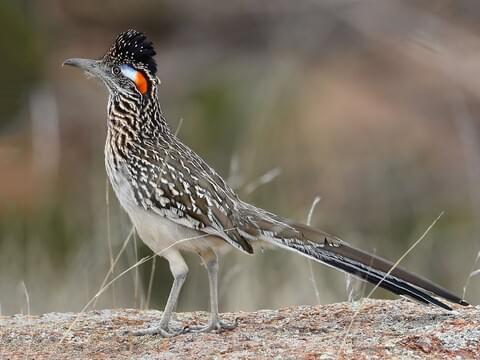
we can find greater roadrunners everywhere in southwest America including seas at heights of up to 3000 meters (10000 feet) most times they prefer to live in areas where there is grass near the rivers.
this bird feeds on insects, frogs, reptiles, and other small birds or dead birds in addition they can hunt fish if there is any river or sea near them, their long beak helps them do this. they also feed on plants, fruits, and seeds to make up for what they didn’t eat from the mare, especially in the winter season.
Before they eat any of their prey like snacks or frogs, they click it using their beak to kill it and make it easy to eat, they do not fly a lot but they are so fast and this helps them to hunt their prey easily.
Greater Roadrunners often construct their nests in thorny shrubs, low trees, cacti, or even on man-made structures like fences or utility poles. and the nests are made of sticks, twigs, leaves, grass, and sometimes feathers. They may also include various objects such as snakeskins, papers, or bones, possibly for camouflage or decoration purposes.
the breeding season usually starts from March to July, although it will be different due to the area, by the way, they lay from 2-6 eggs and the incubation take around 20 to 21 days. After hatching, the chicks stay in the nest for approximately 18 to 21 days before fledging.
7- Pharaoh Eagle-Owl:
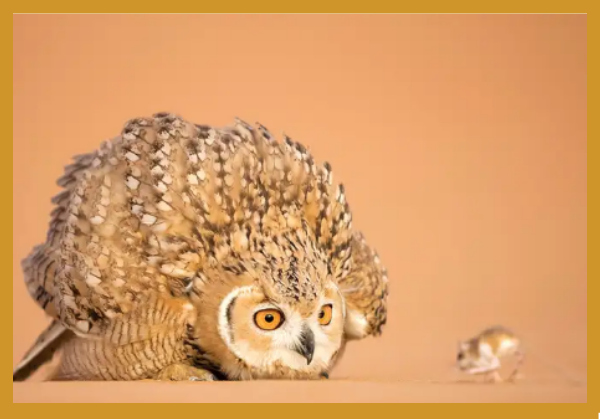
Pharaoh Eagle Owl (Bubo Ascalaphus) is a mix between the eagle and the owl, it is from the Strigidae family It is found in Morocco, Iraq, Chad, Eritrea, Iraq, Israel, Egypt, Jordan, Mauritania, Libya, Mali, Algeria, Oman, Qatar, Palestine, Saudi Arabia, Senegal, Niger, Tunisia, United Arab Emirates, Sudan.
the size of this eagle is big a little, it’s around 45 to 50 cm. Tail length 160-233mm. Wing length 324-430mm, Weight about 1900-2300g. Females are larger and heavier than males.
this eagle primarily sustains itself by preying upon diminutive vertebrates, including mammals, birds, and reptiles. It demonstrates a versatile palate by occasionally indulging in larger insects and scorpions as well. While rodents compose a significant portion of its menu, this remarkable owl exhibits its prowess by capturing hares, bats, desert foxes, and hedgehogs as well. Notably, the Pharaoh Eagle Owl employs a patient hunting technique, predominantly seizing its targets while perched gracefully, ready to strike with precise accuracy.
their breeding time starts early, typically in the first month of the year from January to March, they lay 2-4 eggs, the incubating period for this eagle is longer than other birds because they incubate around 32 to 34 days.
8-Tristram’s starling:
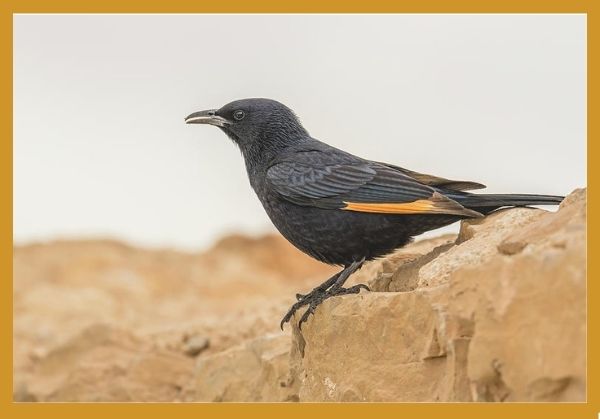
Tristram’s Starling this name is named after the nature scientist Canon Henry Baker Tristram after the 19th century, This bird can primarily be found in specific regions of the Middle East and North Africa,
Tristram’s starling size is medium, measuring about 24 centimeters in length, Its most striking feature is its distinctive plumage. The bird is predominantly black, with iridescent violet-blue feathers adorning its wings, tail, and neck. The contrast between the glossy black and vibrant blue creates a captivating and visually stunning spectacle.
If you are a bird watcher and lover let me give you some countries where you can find them: Israel, Jordan, Saudi Arabia, Sinai Penisula in Egypt, Oman, and Yemen, These places are the most suitable for their needs including The weather, deserts, dry trees, highlands and mountains, and a dry climate.
and if someone needs to read and know about the best desert birds of prey you can find them here.
9-Gambel’s quail:
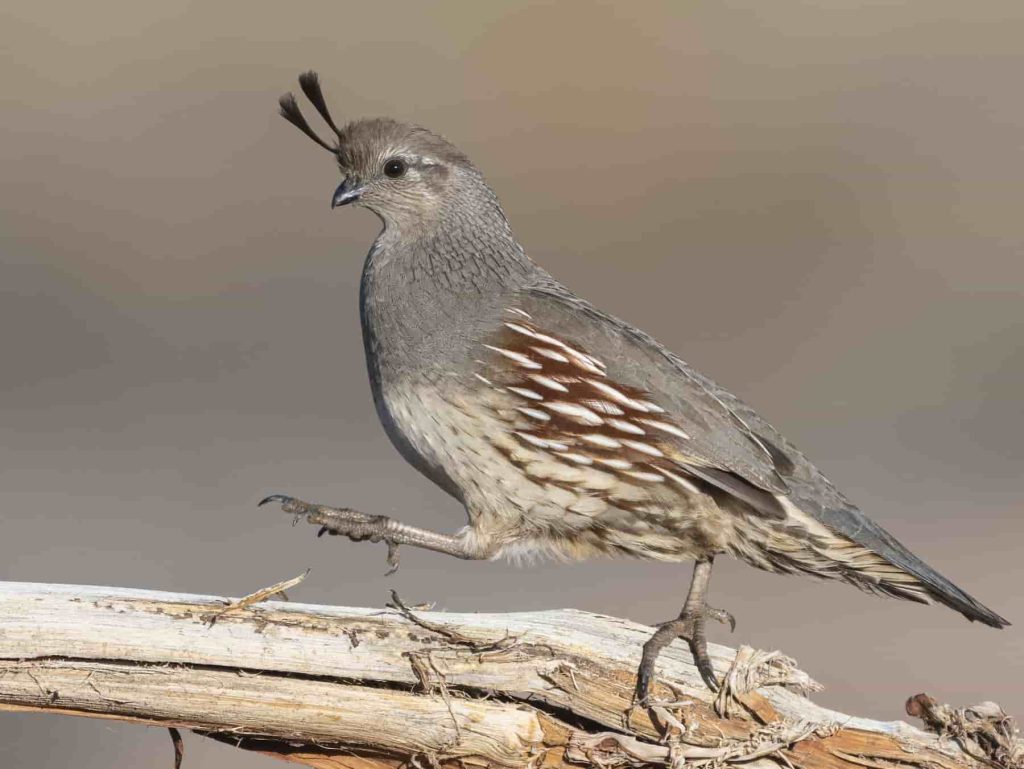
Gambel’s quail or Callipepla gambelii is a small desert bird in the quail family, we can find it in America in some states like Arizona, Mexico, Colorado, California, Texas, and Nevada in addition to the New Mexico border Chihuahua.
Gambel’s quail size is small to medium as it can be 11 to 12 inches (28 to 30 centimeters) in length. They have a plump, rounded body with a short, slightly curved crest on their head. The male and female quails have similar markings, including a distinctive teardrop-shaped black plume on their forehead and a scaly appearance on their underparts.
9. Bearded Vulture:
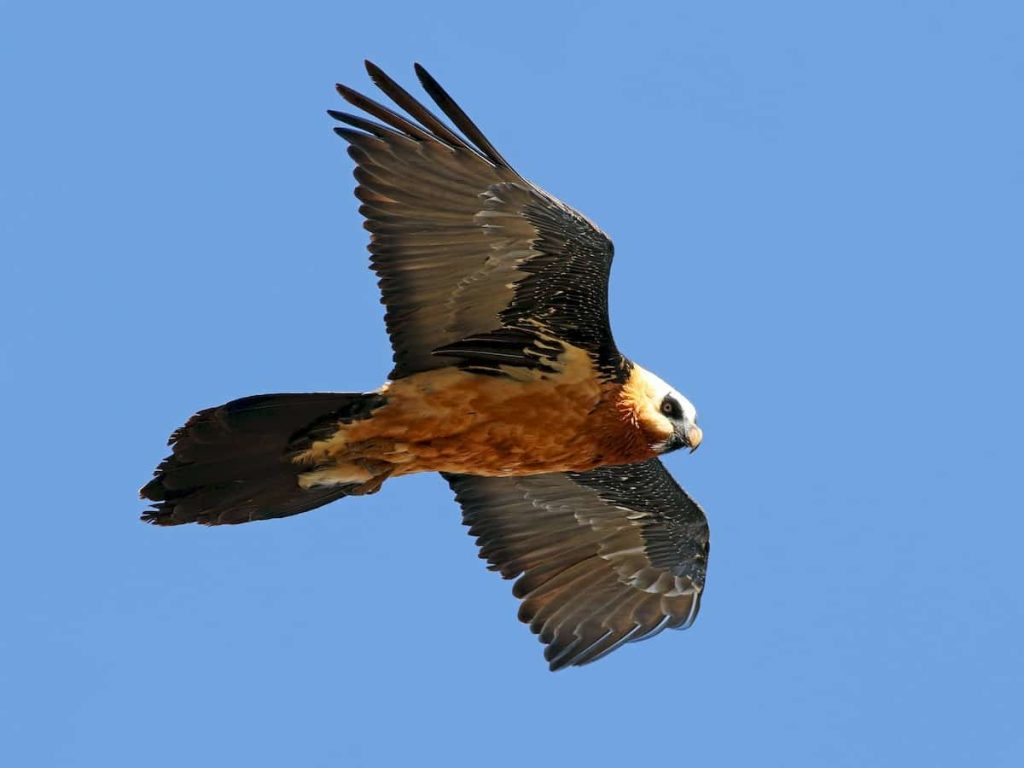
a lover of mountainous regions of Europe, Asia, and Africa, these are the best places for this species to stay. The bearded Vulture (Gypaetus barbatus) is a striking species that stays all its life at heights and peaks watching what is moving below.
The Bearded Vulture has a wingspan of about 7 to 9 feet (2.3 to 2.8 meters) and features a rusty orange to rust-brown plumage, contrasting with a whitish head and neck.
10. Phainopepla:
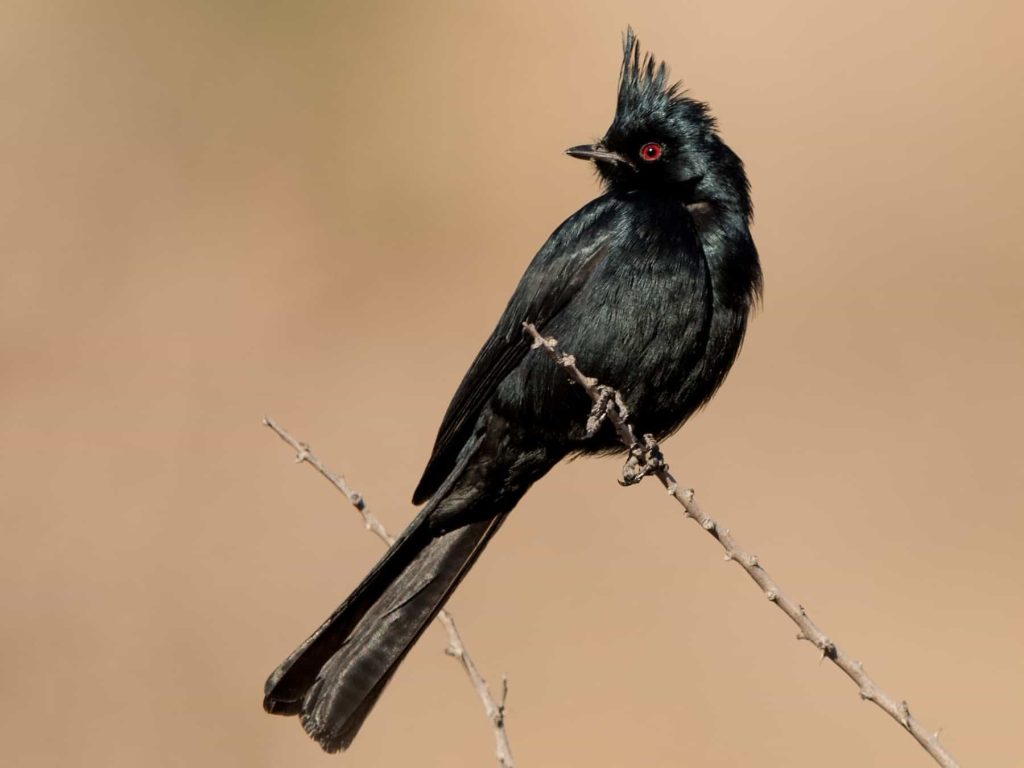
Phainopepla or (Phainopepla nitens) is one of the most beautiful species with full black color as the male has glossy black plumage and the female is grayish in color with a slightly crested head in addition to red eyes they have both.
the native of Phainopepla is from the United States and you can find them in desert and semi-desert regions. they feed primarily on mistletoe berries and they can disperse mistletoe seeds.
What kind of birds live in the desert?
There are many birds in the desert and many species you can find including Falcons, Eagles, Larks, Hawks, Sparrows, Owls, warblers… as you can find them in any desert area where there is some water. they exist near lakes like groups once they drink they fly and walk in the semi-green spots to hunt some insects and eat some Cereales.
But the large species like eagles and falcons they looking for prey to hunt in the high places above the mountains or the dunes to see the other wild animals not always other birds.

